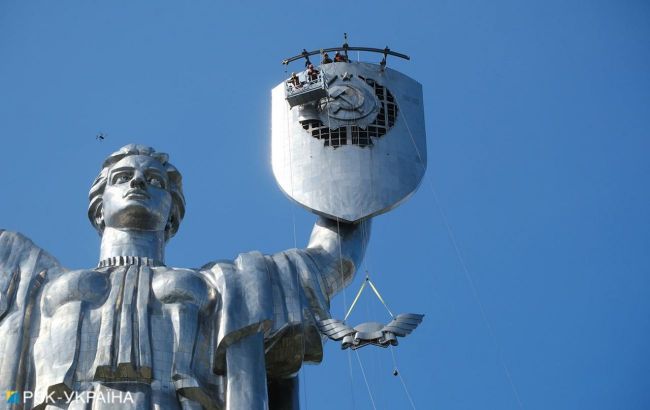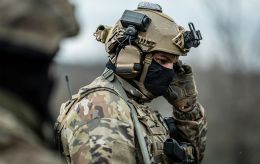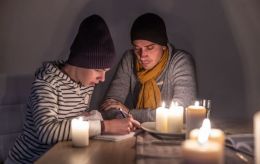Big Mama with a sword and trident instead of a hammer and sickle: Myths about the monument
 Motherland Monument to be renamed and a communist symbol replace with trident (Photo: RBC-Ukraine, Vitalii Nosach)
Motherland Monument to be renamed and a communist symbol replace with trident (Photo: RBC-Ukraine, Vitalii Nosach)
In the past few years, Ukraine has come a long way in ridding itself of symbols from its totalitarian communist past. With the onset of a full-scale Russian invasion, the urgency to eliminate remnants of the Russian and Soviet occupation from the public space has become even more apparent. Currently, the spotlight is on one of Kyiv's most iconic landmarks – the colossal statue of "Motherland," which bore the Soviet emblem on its shield. Now, the process of dismantling this emblem is in full swing, to be replaced by the Ukrainian trident. The monument itself is planned to be renamed "Mother Ukraine."
These actions have sparked intense debates within Ukrainian society, with opinions ranging from the complete demolition of the monument to leaving it untouched until the war is over, focusing instead on issues directly related to Ukraine's defense.
In a column for RBC-Ukraine, historian and senior researcher at the National Museum of Ukrainian History during World War II, Roman Kabachiy, sheds light on the main arguments and myths surrounding these processes.
"This is a Soviet monument and it should be removed"
Contrary to popular belief, the Motherland Monument is a Ukrainian creation designed by sculptor Vasyl Boroday during the Soviet era. The monument was cast from stainless chrome-nickel steel in Zaporizhzhia, using constructions from the Paris Commune Factory in Kyiv. The facial features of the monument were modeled after the Ukrainian sculptor Halyna Kalchenko. Vasyl Boroday's father collaborated with Dmytro Yavornytskyi in forming the funds for the current Yavornytskyi Museum, and Vasyl himself was a contemporary of Ukrainian statehood, born in 1917 in Katerynoslav.
According to Boroday's student, Oleksii Pergamenshchyk, who is also the author of the trident project for the monument, "...our sculpture wears an ancient Greek chiton. Vasyl Boroday, a well-known Ukrainian sculptor and patriot, modified it to minimize its Soviet connotations. This statue connects us with the Hellenistic past, to the origin of classical art."
"The riveted woman will never become Ukrainian"
In Europe, there are many examples of monuments erected for one purpose, but now serving a completely different role. Even in Kyiv, there are such examples. During the Museum Council devoted to redefining the monument, our historian Ihor Hyrych wisely pointed out that "we do not say today that we should remove the monument to Volodymyr the Great, which was erected by Russian tsars to assert their authority over Kyiv in the mid-19th century. The monument to Bohdan Khmelnytsky was a symbol of Moscow's power; it represented the Pereyaslav Council from the Russian perspective."
Moreover, the first project of the monument to Khmelnytskyi, created by sculptor Mykhailo Mykeshyn, was overtly chauvinistic and anti-Polish - Khmelnytskyi's horse trampled the body of a Jesuit priest covered with a torn Polish flag, and next to him, there was supposed to be a broken chain symbolizing liberation from the "Polish yoke." The inscriptions on the pedestal reminded of the monument's Moscow orientation: "For the King of the East, Orthodox" and "To Bohdan Khmelnytskyi, indivisible Russia." In 1919 and 1924, these inscriptions were replaced with "Bohdan Khmelnytskyi. 1888." This inscription can still be seen today. The same will happen with the Motherland Monument.
"No need for a name change"
The proposal to rename the monument to "Mother Ukraine" was unanimously supported by the Council of the museum during the meeting on July 25, 2023. The Council consisted of, among others, Ihor Hyrych from the Institute of Ukrainian Archaeography and Source Studies of the National Academy of Sciences of Ukraine (NASU), Oleksandr Lysenko and Valerii Tomazov from the Institute of Ukrainian History of NASU, Oleh Tsapko from the Institute of World History of NASU, and Ivan Patrylyak, the dean of the History Faculty at Taras Shevchenko National University of Kyiv.
Apart from distancing our Motherland Monument from the one in Volgograd and reducing speculations about the "sisters" theme, as the Russian version of our monument was also called "Motherland," it also challenges Russian propaganda that quickly labeled our sculpture as "Russian woman" and claimed that removing the Soviet emblem was a form of "defilement."
"Mother Ukraine" will not be a "Russian woman"
Oleksandr Lysenko argued in favor of the name change during the Council meeting, stating: "Rejecting the phrase "Motherland" is a deconstruction of a part of the Soviet myth, and it is logical. A figure of such scale and symbolism deserves its own myth. We shouldn't fear this word. We must construct a new historical myth around this figure: scientifically substantiated, romanticized, and there's nothing wrong with that. This is how things are done everywhere."
"Hanging the trident on the shield is a disrespect to the trident. It's better to leave a hole"
To quote sculptor Oleksii Pergamenshchyk: "We are changing the devil's eye, which shines upon all of Ukraine, a mark of the beast, to the ancient symbol of St. Volodymyr, who was born right here, on these Kyiv hills, over a thousand years ago. We affirm the ancient Rus-Ukraine. This is not a symbol invented in 1991. This is the ancient symbol of one of the most powerful states of that time."
The trident will be slightly larger than the Soviet emblem, visible from afar, smooth, and shining in the sun. Leaving a hole is physically impossible ("let it be a symbol of Ukraine's wound from the war!"), as the wind would blow through the shield's emptiness. The trident on the shield, with a sword aimed at the aggressor state, is a symbol of protection and confidence. And yes, the idea of comparing "Mother Ukraine" to the Oranta of Saint Sophia Cathedral has the right to exist; it is part of the monument's new myth.
Ihor Hyrych shared: "Yurii Sheleh, a sixtier, who worked at the factory in Zaporizhzhia, where they made constructions from this steel and brought them from the Sviatoshyn railway station, always said, 'I love it very much; it's such a beautiful modern monument.' He, as someone who endured those times, always had a positive attitude toward it and was always proud of this monument. And that is very normal."
Lastly, foreign delegations visiting the museum as part of their tours, which include current exhibitions such as "Ukraine - Crucifix" from the de-occupied territories of Kyiv and Chernihiv regions, "Talismans from the War," "Children," always ask the museum management to come closer to the monument. It is not only taller than the Statue of Liberty but also among the three tallest monuments in Europe.
Similarly, Motherland Monument, soon to be "Mother Ukraine" (acting Minister of Culture Rostyslav Karandeev supports the name change), is of interest to both foreign tourists and those from Ukraine. They bring money to the museum, which is now in need of re-exposition of the main exhibition beneath the monument. These are real funds earned by culture during wartime.

